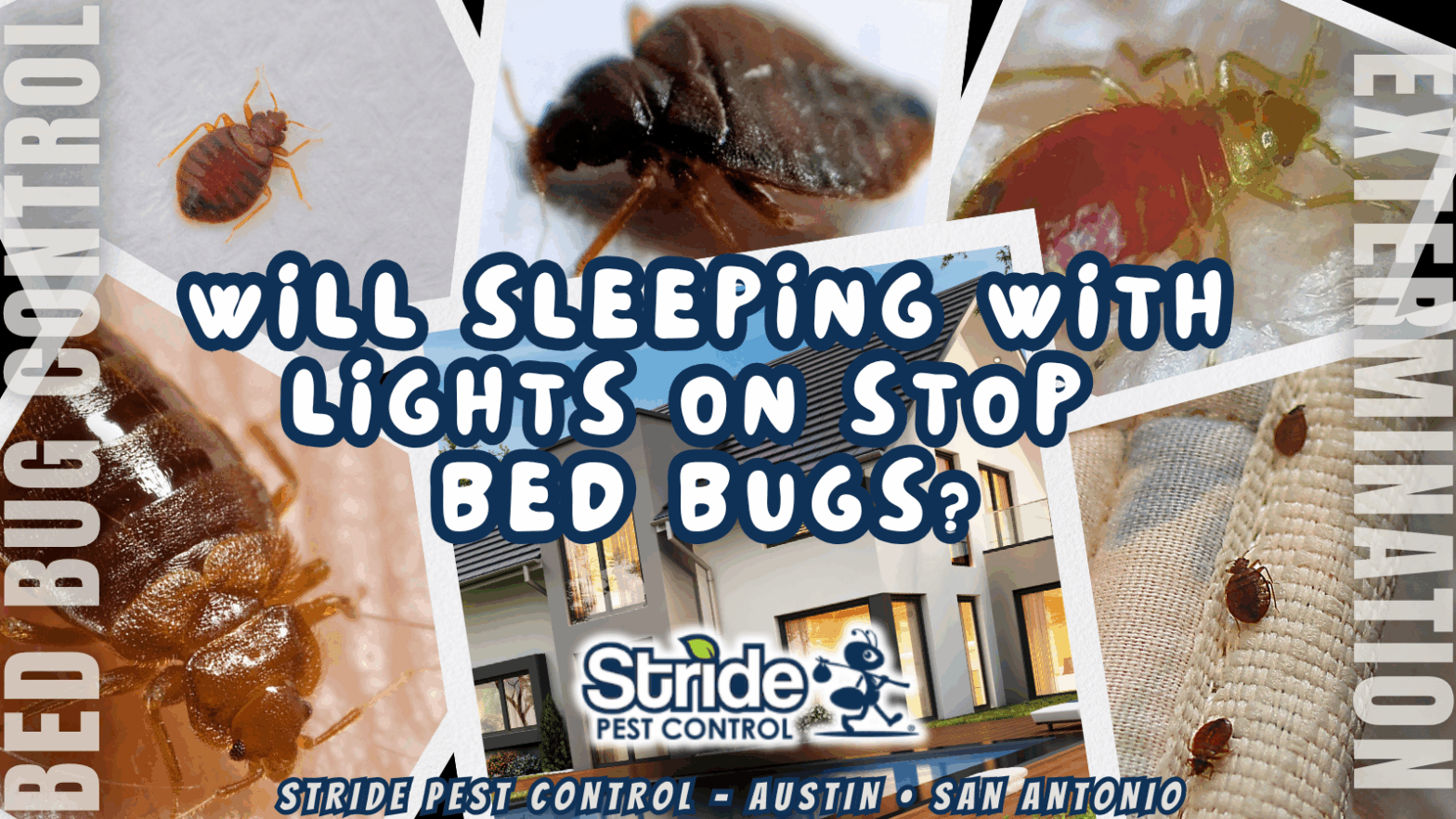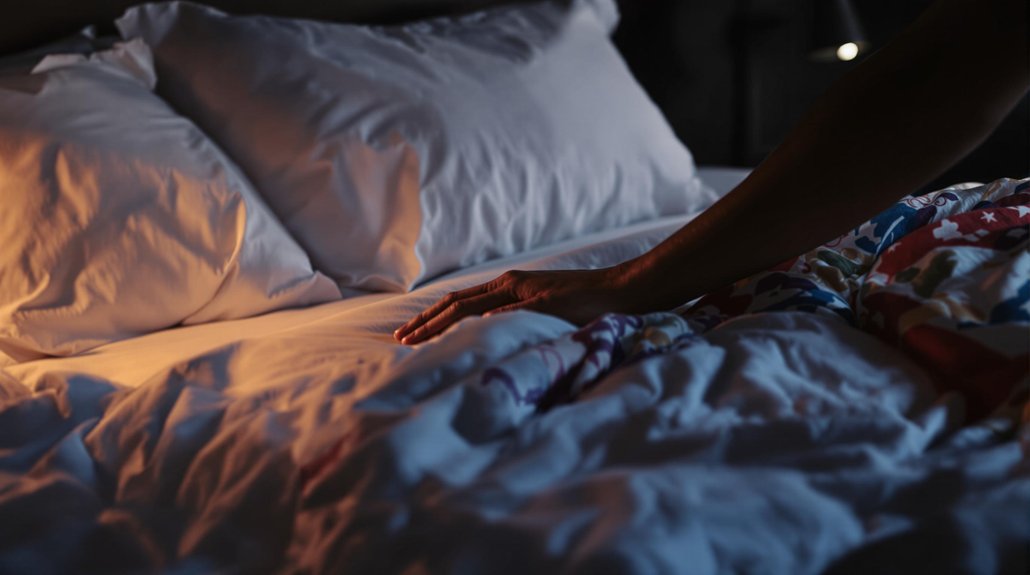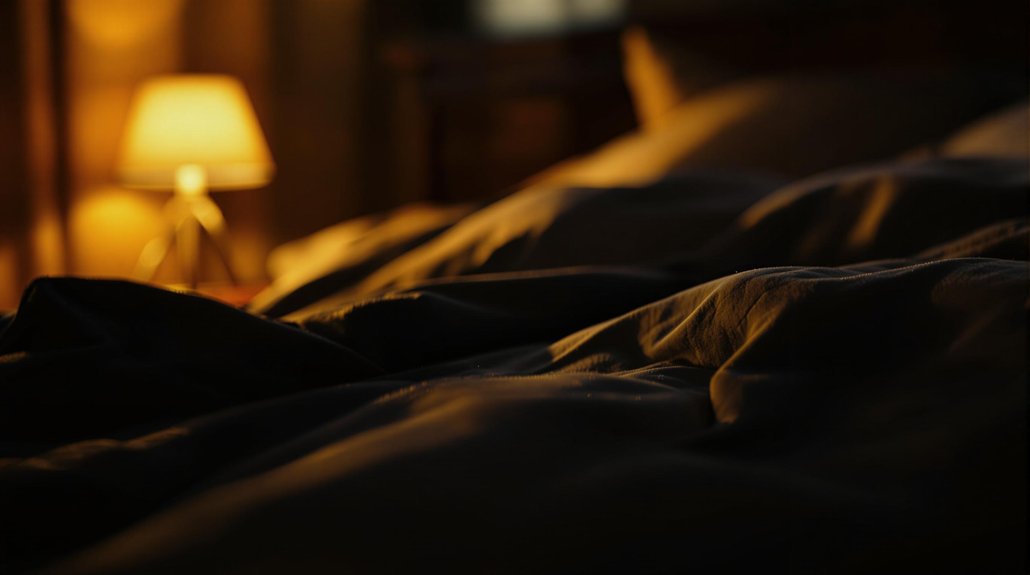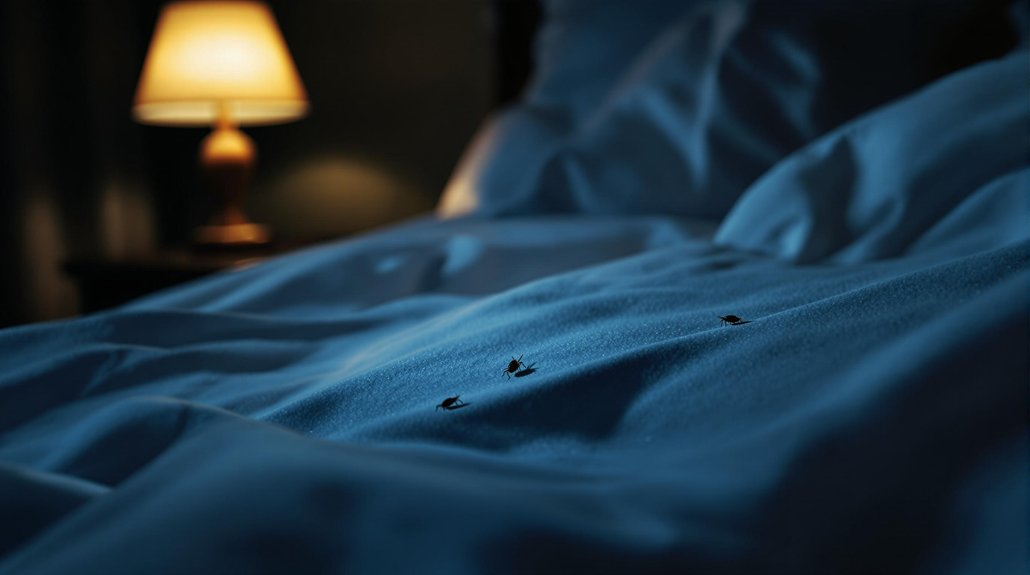
Sleeping with lights on does not stop bed bugs from feeding or reduce their presence. Bed bugs are primarily nocturnal and prefer dark environments, but they will still bite if they find a host. Light may make them less active during the day, but it does not prevent them from approaching a person in bed. To learn more about bed bug behavior and effective strategies, further information is available.
Key Article Highlights
- Bed bugs are nocturnal and primarily active at night, but they can feed regardless of light conditions.
- Bright lights do not kill or repel bed bugs effectively.
- Bed bugs usually hide in dark crevices, but may still feed during the night if disturbed.
- Sleeping with lights on does not prevent a bed bug infestation or bites.
- Effective control relies on inspection, cleaning, and pest management, not just lighting changes.
What Do Bed Bugs Really Prefer?

What do bed bugs truly prefer when it comes to their environment? Bed bug habitat is typically characterized by darkness and close proximity to their human hosts. They are nocturnal creatures that avoid light, displaying a strong preference for low-light conditions. Their light preferences guide them to hide during daylight hours under beds, behind wallpaper, or in cracks and crevices near sleeping areas. These insects seek environments that offer warmth and concealment, reducing exposure and increasing survival chances. Light exposure acts as a deterrent, prompting bed bugs to retreat into darker, undisturbed hiding spots. Additionally, environmental factors such as temperature and humidity play crucial roles in their habitat choices. Understanding their habitat and light preferences allows for strategic control measures, as disrupting their preferred conditions can hinder their ability to stay hidden and reproduce.
The Science Behind Bed Bug Behavior and Light
Research indicates that bed bugs have evolved to respond strongly to light, which influences their behavior and habitat selection. Light exposure plays a significant role in bed bug attraction, guiding them toward dark areas where they typically hide during the day. When exposed to light, bed bugs may become less active or relocate to darker, more secure environments. Their sensitivity to light helps them optimize feeding and survival by avoiding illumination that could alert their hosts. This behavior suggests that light exposure does not necessarily deter bed bugs but instead affects their movement patterns. Understanding this relationship is essential for controlling infestations. Proper manipulation of light can influence their activity, making light a potential tool in integrated pest management strategies.
Do Bed Bugs Avoid Light?

Bed bugs are generally sensitive to light, which influences their activity patterns. They tend to be active during darkness and avoid well-lit areas. Exposure to light can reduce their presence, but it does not completely eliminate infestations.
Bed Bugs and Light Sensitivity
Sleep environments are often influenced by the behavior of bed bugs, which are known to seek out hosts for feeding. Bed bug habits show that they are sensitive to light exposure, typically preferring dark, hidden areas where they can remain undisturbed. While they do not completely avoid light, they tend to avoid open, brightly lit spaces during their active periods. Bed bugs are primarily nocturnal, aligning their activity with low-light conditions to enhance their feeding success and survival. Their light sensitivity influences where they hide during the day, often in cracks and crevices undetectable to the naked eye. Consequently, light exposure can play a role in their movement and hiding patterns, although it does not necessarily eliminate their presence.
Nocturnal Behavior Patterns
While bed bugs are active during the night, they do not completely avoid light. Their nocturnal feeding behavior can be influenced by light attraction, but they tend to prioritize safety over darkness when necessary. Bed bugs often feed when hosts are still or asleep, yet they may be active in well-lit environments if disturbed or threatened. Understanding their nocturnal behavior patterns reveals that lights alone do not fully prevent their activity, though lights may influence their movement. Factors like host presence and environmental conditions also impact their activity. Bed bugs are adaptable, capable of adjusting their feeding times based on conditions. Knowledge of their behaviors supports targeted control strategies. Recognizing light attraction tendencies helps in developing more effective methods to manage infestations.
Light’s Impact on Infestations
Despite their nocturnal tendencies, bed bugs do not completely avoid light. Their light preferences are more complex, with some situations prompting exposure rather than avoidance. Bed bugs are generally sensitive to light, often retreating to hiding places when exposed to sudden or intense light sources. However, steady, low-level light exposure during sleep does not necessarily eliminate them, as they can adapt or remain hidden until the light diminishes. Research indicates that light exposure can influence their behavior, making them less active or prompting movement away from illuminated areas. Nevertheless, relying solely on light to control infestations is ineffective. Successful management requires understanding bed bugs’ responses to light and implementing thorough strategies. Light’s impact alone cannot eradicate an infestation but can play a supporting role in integrated pest management.
How Bed Bugs Find Their Hosts

Bed bugs locate their hosts primarily through their highly sensitive sense of smell and heat detection. They rely on these senses for effective host detection and bed bug attraction. Their antennae are equipped with receptors that detect human scent molecules, carbon dioxide, and body heat, enabling them to pinpoint a host’s location from a distance.
- Bed bugs are attracted to carbon dioxide exhaled during breathing
- Body warmth guides them directly to their target
- Human scent molecules help in close-range host detection
- Increased body heat intensifies bed bug attraction
- Movement can trigger additional host detection responses
These mechanisms make bed bugs highly efficient at finding hosts, especially in dark or concealed environments. Understanding these cues is essential for grasping their host detection process.
Can Sleeping With Lights on Reduce Bed Bug Bites?
Keeping lights on during sleep can disrupt bed bugs‘ natural behavior and their ability to feed. Since they prefer darkness to locate hosts, bites are less common in well-lit rooms. However, this method does not eliminate the presence of bed bugs or fully prevent bites.
Lights Disrupt Bedbugs’ Habits
Lights can influence bedbugs’ behavior by disrupting their natural hiding and feeding patterns. Light exposure alters their usual habits, making them less likely to seek hosts during illuminated periods. This disruption can reduce their feeding frequency and disturb their effective hiding routines.
Key points include:
- Bedbugs tend to avoid light, reducing their activity during bright periods.
- Continuous light exposure can hinder their ability to locate hosts.
- Regular lighting may delay or prevent bedbug reproduction cycles.
- Disrupted bedbug habits can lead to decreased infestations over time.
- Using lights strategically could make environments less inviting for bedbugs.
Targeted light exposure helps manipulate bedbugs’ behavioral patterns, offering a non-chemical way to control their presence.
Bites Less Likely at Night
Does sleeping with lights on actually reduce the likelihood of bed bug bites? Bed bugs are nocturnal creatures that prefer darkness when feeding. Their nighttime habits rely on limited light exposure to navigate and locate hosts. When lights are on during sleep, their activity may decrease, making bites less likely. However, this does not guarantee protection, as bed bugs can still feed if disturbed. Light exposure can disrupt their behavior, but it does not eliminate the risk entirely. Focusing on the environment to make it less attractive, such as reducing clutter and sealing entry points, remains effective. While daytime or well-lit sleeping environments may reduce bites, complete prevention requires integrated pest management. Relying solely on light exposure is insufficient for full control.
Factors That Influence Bed Bug Activity at Night
What factors influence bed bug activity during the night? Bed bug activity is affected by various factors tied to their habitats and environmental conditions. These insects prefer dark, concealed areas near their hosts. Environmental conditions such as temperature and humidity greatly impact their activity levels. Warmer, humid environments make bed bugs more active, increasing their likelihood to feed. Additionally, their habitats—closely associated with bedding, furniture, and clutter—provide resting places that influence movement at night. Light levels can deter or encourage activity depending on the insect’s natural tendencies. Noise, vibrations, and carbon dioxide emissions from sleeping humans also stimulate their behavior. Understanding these factors helps in managing infestations and predicting when bed bugs are most likely to be active.
Practical Ways to Detect Bed Bugs in Your Bedroom
Identifying bed bugs requires careful observation. Visual inspection involves checking mattress seams, furniture, and cracks for bugs or eggs. Additionally, noticing signs like dark spots or shed skins helps confirm their presence.
Visual Inspection Techniques
Effective visual inspection is essential for early detection of bed bugs in a bedroom. Detecting visual cues such as shed skins, dark spots, and tiny eggs helps identify infestations promptly. Proper inspection tools, including a flashlight, magnifying glass, and a stiff card, enhance accuracy. Methodical examination of bedding, mattress seams, behind headboards, and furniture crevices reveals subtle signs. Regular inspections prevent hidden populations from establishing, enabling timely treatment. Familiarity with visual cues guarantees swift recognition of early indicators. Using a flashlight helps highlight bed bugs in cracks and seams, while a magnifying glass clarifies small details. A stiff card can dislodge insects from tight spaces. Vigilant, systematic inspections with appropriate tools empower homeowners to master bed bug detection effectively.
Bed Bug Behavioral Signs
Bed bugs exhibit specific behavioral signs that can help with detection in a bedroom. Their bed bug habits often include hiding in seams, mattress folds, and cracks near sleeping areas. They are nocturnal and tend to come out at night to feed, making their activity noticeable through bites or live sightings. Understanding light exposure’s effect on bed bugs is essential; these insects prefer darkness and are less active in well-lit environments. During daylight, they tend to hide, but their presence can still be inferred from signs like shed skins, small blood stains, or dark spots of droppings. Recognizing these behavioral signs enhances the ability to identify an infestation early and target inspection efforts effectively. Mastery of bed bug habits and light exposure patterns supports successful detection and control.
Effective Strategies for Bed Bug Prevention and Removal
Implementing proper prevention and removal techniques is essential in managing bed bug infestations. Effective strategies focus on proactive pest control and minimizing hiding spots. Regular inspection of bedding, furniture, and luggage can detect early signs of bed bugs. Encasing mattresses and box springs in tight, bed bug-proof covers prevents pests from entering or escaping. Vacuuming and steam cleaning infested areas help eliminate bed bugs and eggs. Removing clutter reduces hiding places, making inspections more effective. Using approved insecticides safely can also control infestations. Combining these methods guarantees higher success in eradication. Consistent monitoring and early intervention are key to preventing major outbreaks. Most importantly, understanding bed bug behavior enhances pest control efforts, reducing reliance on ineffective solutions. These strategies foster mastery in bed bug prevention and removal.
Common Myths About Bed Bugs and Light
Many people believe that sleeping with the lights on can deter or eliminate bed bugs, but this is a common myth. Bed bug myths often involve misconceptions about their behavior, especially regarding light. Light misconceptions suggest that bed bugs avoid illuminated areas and are solely active in darkness. However, research shows that bed bugs are nocturnal but will feed regardless of light presence if they find a host. They hide during the day and become active at night, independent of lighting conditions. Sleeping with lights on does not kill or repel bed bugs effectively. This misunderstanding can lead to false confidence and delayed treatment. Educating oneself about these bed bug myths is essential to develop effective pest control strategies based on facts, not misconceptions.
Tips for Keeping Your Sleeping Area Bed Bug-Free
To reduce the risk of bed bugs in a sleeping area, regular cleaning and inspection are essential. Check bedding, furniture, and nearby areas frequently for signs of infestation. Using bed bug traps under the bed legs can help monitor and capture bed bugs early. Mattress encasements are effective in preventing bed bugs from hiding in mattresses and make detection easier. Avoid clutter around the sleeping area to limit hiding spots. Wash and dry bedding regularly on high heat. Seal cracks and crevices in furniture and walls.
- Install bed bug traps beneath bed legs
- Use mattress encasements to block infestations
- Keep the sleeping area clutter-free
- Regularly inspect and vacuum the room
- Wash bedding frequently on high heat

